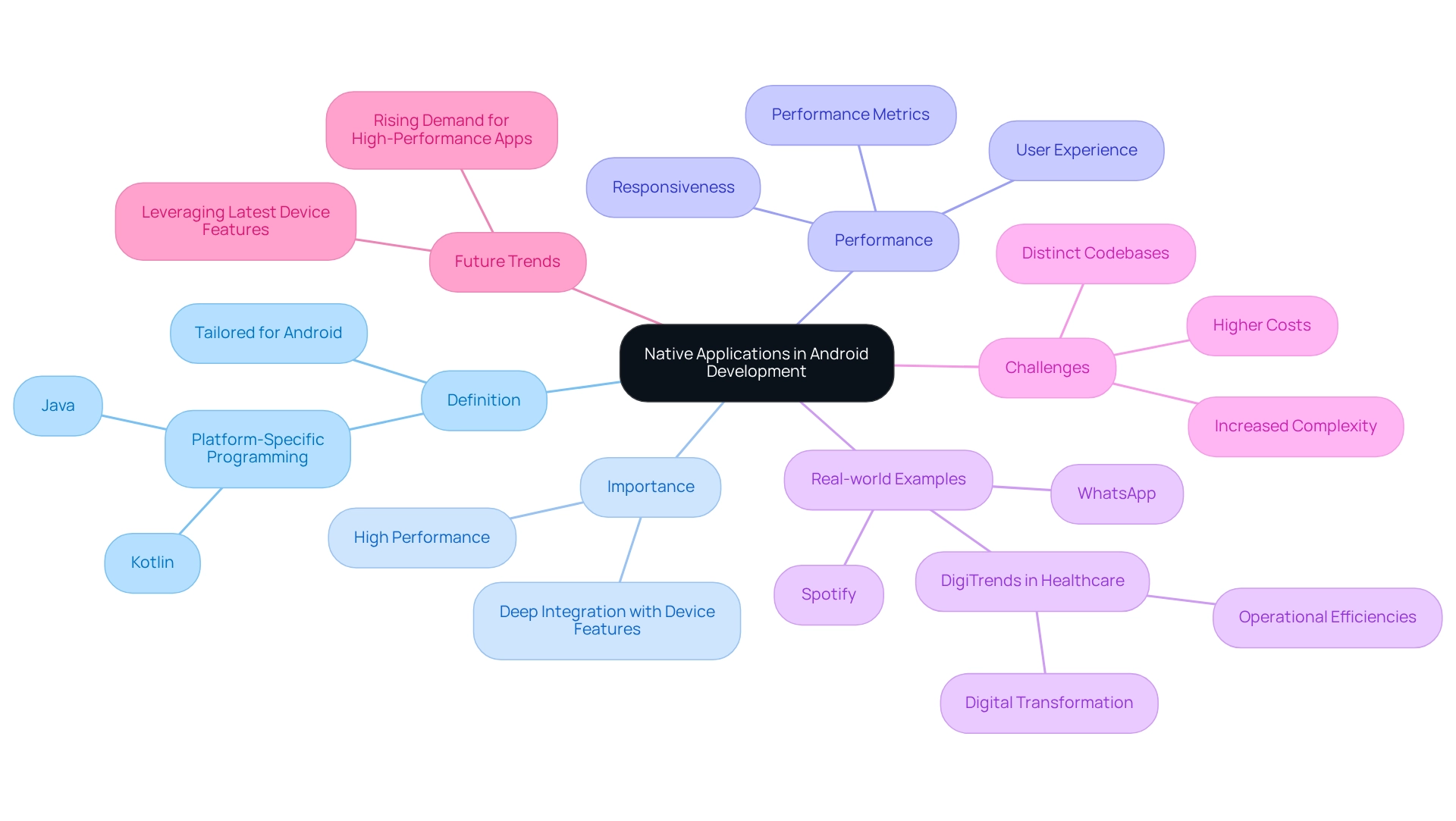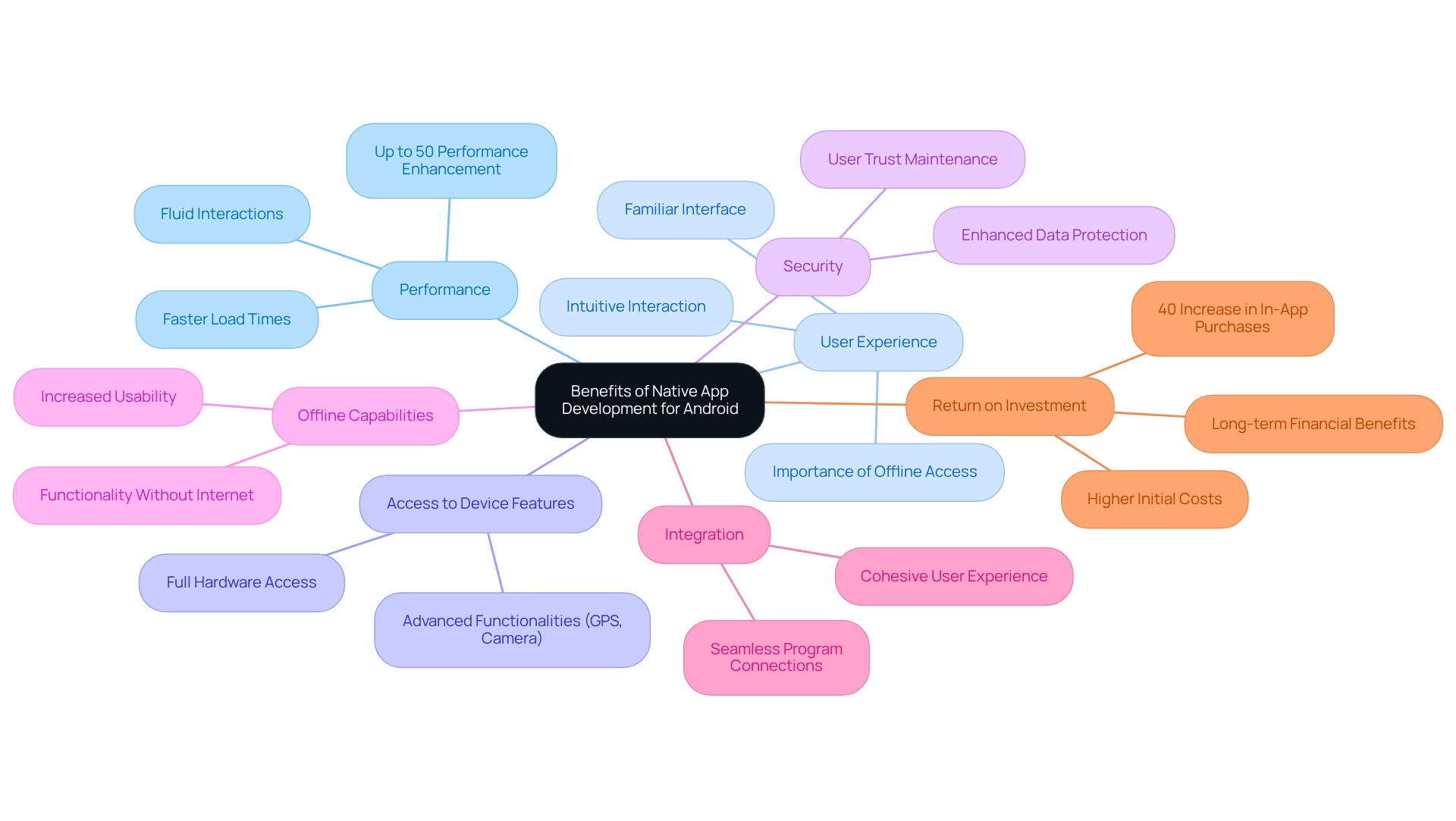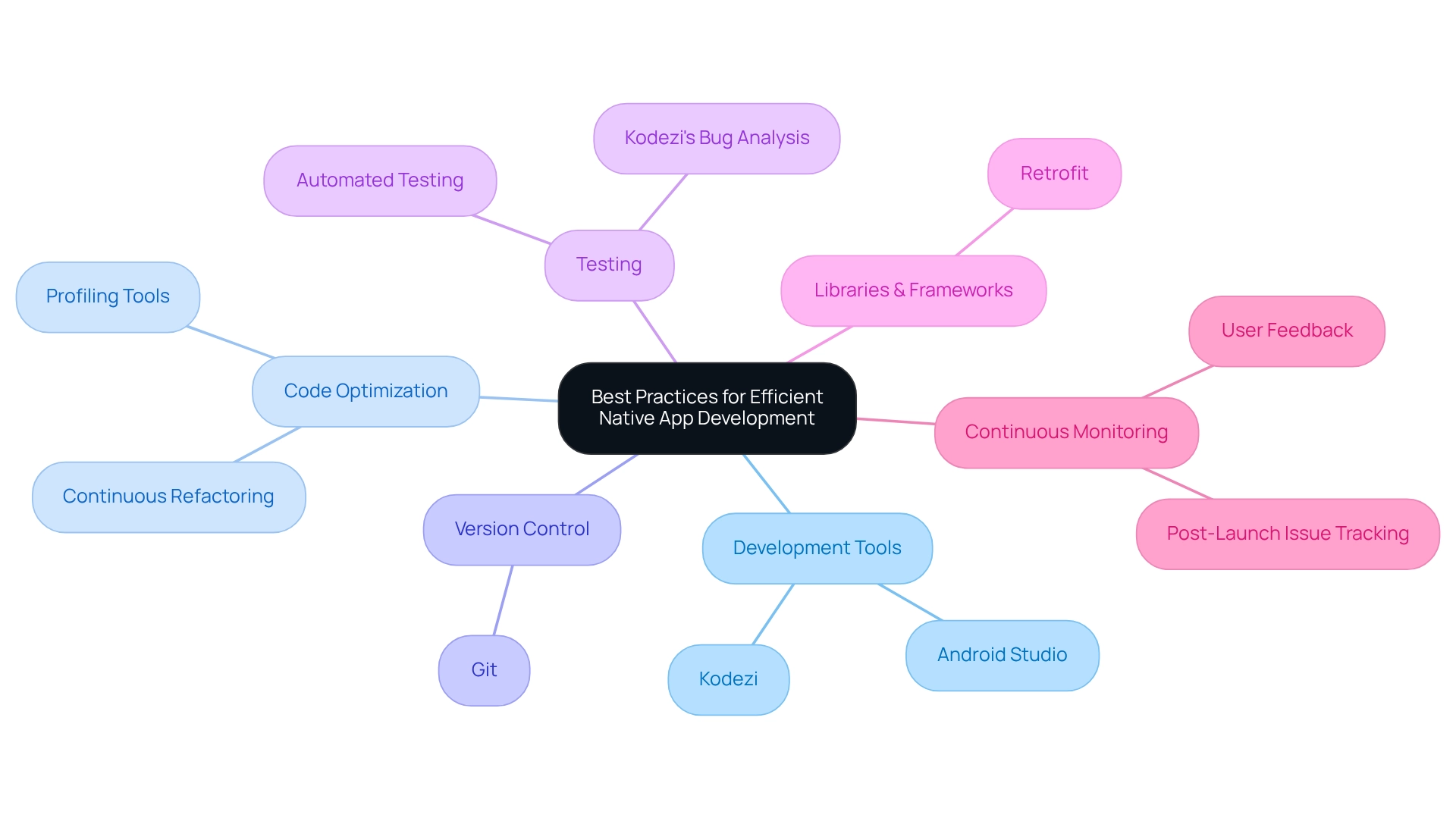Overview
The article emphasizes the importance of mastering native application development in Android to achieve optimal efficiency. It highlights that native applications deliver superior performance and user experience while providing access to essential device features. These factors are crucial for developers striving to create impactful mobile solutions. Real-world examples and statistical data further illustrate the advantages of native applications over hybrid alternatives, prompting developers to consider the significant benefits of focusing on this area.
Introduction
In the competitive landscape of mobile application development, developers face numerous challenges, particularly in delivering high performance and engaging user experiences. Native apps emerge as a solution, standing out as a beacon of performance and user engagement. Tailored specifically for platforms like Android, these applications leverage the full power of device hardware and software, resulting in unmatched speed and responsiveness.
How can developers create immersive experiences that resonate with users? Understanding the significance of native app development becomes crucial. Native apps enhance user satisfaction through intuitive interfaces and ensure seamless access to device features. They are not just a trend; they are a necessity for high-performance applications.
As the demand for sophisticated mobile solutions continues to rise, embracing the best practices and advantages that native development offers is essential for success.
Define Native Applications and Their Importance in Android Development
A native application in Android is a software program specifically designed and tailored for that particular platform. By utilizing platform-specific programming languages like Kotlin or Java, these applications fully harness the device's hardware and software capabilities. This specialization results in superior performance, responsiveness, and user experience compared to hybrid or web applications.
In the realm of Android programming, standard apps are essential for applications that require high performance and profound integration with device features. They excel in scenarios involving complex tasks, such as gaming or real-time data processing, where performance is paramount. While statistics on developer preferences for conventional app development vary, it is evident that many developers acknowledge the benefits of this approach.
Real-world examples further illustrate the advantages of native applications. For instance, applications like WhatsApp and Spotify, developed natively, consistently outperform their hybrid counterparts in terms of speed and engagement. These applications leverage device-specific features, providing a seamless user experience that hybrid apps often struggle to achieve. Furthermore, the case study of DigiTrends emphasizes how digital solutions have transformed the healthcare sector, illustrating the impact of local applications in a specific industry.
However, developers should also be mindful of common pitfalls in app creation, such as the increased complexity and cost associated with building and maintaining distinct codebases for different platforms. As we progress into 2025, the significance of native applications in Android development continues to expand, driven by the rising demand for high-performance applications that can efficiently leverage the latest device features. Chris Galatioto aptly states, 'But when executed properly, there’s no better way to connect with your most devoted clients and introduce your brand to numerous new customers.' The advantages of local applications, including enhanced performance and experience for users, render them a crucial option for developers seeking to create impactful mobile solutions.

Highlight Benefits of Native App Development for Android
The development of a native application in Android presents numerous advantages that significantly enhance both performance and user experience.
Performance: Native apps are tailored for their specific platforms, resulting in quicker load times and more fluid interactions. This optimization facilitates effective resource utilization, ensuring applications operate efficiently and responsively. Recent statistics indicate that original apps can achieve performance enhancements of up to 50% compared to hybrid apps, highlighting their superior efficiency.
User Experience: By adhering to platform-specific design principles, a native application in Android offers a more intuitive interaction. This familiarity fosters satisfaction, as the interface aligns with users' expectations based on their experiences with other applications on the platform. Experts emphasize that prioritizing offline access is crucial for boosting satisfaction and retention.
Access to Device Features: A native application in Android benefits from full access to device hardware and APIs, enabling developers to incorporate advanced functionalities such as GPS, camera, and other device-specific features that hybrid apps may struggle to utilize effectively. As Bilalhusain Ansari notes, integrating features like camera and geolocation is vital for enhancing app functionality.
Security: By leveraging the security features inherent to the operating system, a native application in Android provides a more secure environment for managing sensitive data and transactions, which is essential for maintaining user trust.
Offline Capabilities: A standout feature of native applications is their ability to function without an internet connection. This capability allows users to access features and content anytime, enhancing the app's resilience and usability—an aspect experts highlight as essential for modern mobile applications.
Improved integration is achieved with a native application in Android, as local applications can seamlessly connect with other programs and services on the device, enhancing overall functionality and delivering a more cohesive user experience.
Investing in native application in Android development may involve higher initial costs compared to hybrid or web solutions, yet the long-term benefits often outweigh these expenses. For instance, a retail application that transitioned from hybrid to dedicated programming reported an impressive 40% increase in in-app purchases, illustrating the substantial return on investment (ROI) that companies can anticipate. This case study underscores how a focus on native programming can yield significant financial advantages.
As the landscape of mobile applications evolves, prioritizing offline access and harnessing the full potential of native programming will be crucial for enhancing user satisfaction and retention.

Implement Best Practices for Efficient Native App Development
To ensure efficient native app development, developers often face numerous challenges. How can these be addressed effectively? By leveraging modern development tools, such as Android Studio, developers can create a comprehensive environment for building native apps. Features like code completion, debugging, and performance analysis significantly enhance productivity and code quality. Furthermore, integrating Kodezi, an AI-powered programming tool, streamlines workflows by automatically correcting code and analyzing bugs, allowing developers to focus on core functionalities.
In addition, utilizing Kodezi CLI facilitates collaboration among team members. This tool helps auto-heal codebases, ensuring that developers can work together efficiently without wasting time on pull requests. Adhering to design guidelines is also essential; following Android's Material Design principles when creating a native application in Android results in visually appealing and user-friendly interfaces, leading to higher satisfaction and retention.
Another key practice is to optimize code regularly. Continuous refactoring improves readability and maintainability. As Maria Virginia Rubio states, "By doing this, you can improve the organization of your code, making it easier to maintain and update your app over time." Employing profiling tools to identify performance bottlenecks ensures optimal resource usage and enhances overall app performance. Tools like Kodezi can assist in this process by providing insights and suggestions for code optimization.
Implementing version control systems like Git is crucial for managing code changes, facilitating collaboration among team members, and maintaining a comprehensive project history. Additionally, prioritizing testing is vital. Incorporating automated testing into the creation workflow enables early bug identification and guarantees that the app operates properly across different devices and Android versions, ultimately enhancing user experience. Kodezi's capabilities in automatic bug analysis can significantly enhance this process.
Utilizing libraries and frameworks can also accelerate development and minimize redundancy. For instance, using Retrofit for network calls simplifies API interactions, allowing developers to focus on core functionalities. Continuous monitoring post-launch is essential for tackling problems and improving user experience. As emphasized in the case study 'Final Thoughts on Building a Successful Mobile App,' a systematic approach centered on user feedback and technological innovation prepares the ground for successful mobile app creation.
By adhering to these best practices, developers can improve the efficiency and effectiveness of their app creation processes, ultimately resulting in successful app launches and continuous enhancements. Furthermore, it's crucial to recognize that the expense of creating a mobile app can vary from a few thousand dollars to several hundred thousand dollars or beyond, highlighting the necessity for efficiency in the creation process.

Emphasize the Role of Testing and Optimization in Native Apps
Testing and optimization play a crucial role in the native app development process. Developers often face challenges in ensuring their applications function correctly and efficiently. How can these challenges be addressed effectively?
- Comprehensive Testing is essential. By conducting various types of testing—unit, integration, and acceptance—developers can ensure that every aspect of their app operates as intended. Tools like Kodezi streamline this process by automatically analyzing bugs and providing explanations, making debugging more efficient.
- Performance Optimization is another key consideration. Regularly analyzing app performance with tools such as Android Profiler helps identify slow operations, memory leaks, and excessive CPU usage. Kodezi enhances performance by optimizing code and resources, automatically correcting issues, and generating comments for better understanding.
- Feedback is vital in the testing process. Integrating user feedback helps identify usability issues and areas for improvement. Beta testing can offer invaluable insights before the official launch, ensuring a smoother user experience.
- Continuous Integration/Continuous Deployment (CI/CD) practices automate testing and deployment processes. This ensures that code changes are tested and deployed efficiently. Kodezi's capabilities can seamlessly integrate into CI/CD pipelines, enhancing overall code quality.
- Monitoring and Analytics are essential post-launch. Utilizing analytics tools to track app performance and user behavior provides data that guides future updates and optimizations. Kodezi supports over 30 programming languages, facilitating ongoing development and optimization efforts.
- Unique Positioning is a significant advantage of Kodezi. Unlike other tools, such as Copilot, Kodezi acts as an autocorrect for code, enabling users to debug and resolve coding issues automatically rather than merely autofilling code.
- Pricing Plans make Kodezi accessible to all programmers. With both free and paid options available, developers at every level can benefit from its features.
Are you ready to enhance your coding practices and improve your app development process? Explore the tools available on Kodezi's platform today.
Conclusion
Native applications have become a cornerstone of mobile app development, especially within the Android ecosystem. By leveraging platform-specific programming languages and optimizing for device capabilities, native apps offer unmatched performance and user experiences. The benefits of native app development—ranging from superior speed and responsiveness to enhanced security and offline functionality—underscore their critical role in addressing the needs of modern users.
Furthermore, adopting best practices in native app development can significantly enhance both efficiency and effectiveness. By utilizing modern development tools, adhering to design guidelines, and prioritizing testing and optimization, these strategies are essential for creating high-quality applications. The focus on continuous monitoring and user feedback ensures that apps remain relevant and responsive to user needs, fostering long-term satisfaction and loyalty.
In an increasingly competitive mobile landscape, investing in native app development transcends mere trendiness; it is a strategic necessity. The long-term advantages, including improved user engagement and potential financial returns, present a compelling case for developers to embrace this approach. As technology continues to evolve, the ability to deliver immersive, high-performance applications will be pivotal for success in the mobile market. Embracing native development practices will empower developers to create impactful solutions that resonate with users and distinguish themselves in a crowded marketplace.
Frequently Asked Questions
What is a native application in Android?
A native application in Android is a software program specifically designed for the Android platform, utilizing platform-specific programming languages like Kotlin or Java to fully harness the device's hardware and software capabilities.
What are the advantages of native applications compared to hybrid or web applications?
Native applications offer superior performance, responsiveness, and user experience compared to hybrid or web applications, as they are tailored to leverage the full capabilities of the device.
In what scenarios are standard apps particularly beneficial?
Standard apps are essential for applications that require high performance and deep integration with device features, excelling in complex tasks such as gaming or real-time data processing.
Can you provide examples of successful native applications?
Examples of successful native applications include WhatsApp and Spotify, which consistently outperform their hybrid counterparts in terms of speed and user engagement by leveraging device-specific features.
What challenges do developers face when creating native applications?
Developers may encounter increased complexity and costs associated with building and maintaining separate codebases for different platforms when creating native applications.
What is the future outlook for native applications in Android development?
The significance of native applications in Android development is expected to expand, driven by the rising demand for high-performance applications that efficiently utilize the latest device features.
Why are native applications crucial for developers?
Native applications are crucial for developers seeking to create impactful mobile solutions due to their enhanced performance and user experience, allowing for better connections with clients and opportunities to reach new customers.




